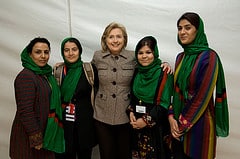
The plight of Afghan women is in the news again. In December, Reuters warned that “(a)larm rises for Afghan women prisoners after Western troops leave,” and Macleans published a plea from Afghan parliamentarian and women’s rights advocate Fawzia Koofi, for Western troops to remain in her country.
Earlier this month, Russia Today reported that:
Violent crimes against women in Afghanistan reached an unprecedented level of brutality in 2013, an Afghan human rights watchdog has announced as the US-led coalition prepares to withdraw.
Chair of the Afghanistan Independent Human Rights Commission (AIHRC), Sima Samar, told Reuters that the pace and the hideousness of attacks on women intensified in 2013 with a 25 per cent surge in cases from March through September.
‘The brutality of the cases is really bad. Cutting the nose, lips and ears. Committing public rape,’ Samar said. ‘Mass rape… It’s against dignity, against humanity.’
The spokeswoman noted that as the withdrawal deadline draws near for international troops, women in tribal areas are less protected, leaving them vulnerable to violent assaults.
‘The presence of the international community and provincial reconstruction teams in most of the provinces was giving people confidence,’ Samar said. ‘There were people there trying to protect women. And that is not there anymore, unfortunately.’
The implication here, of course, is that the “international” (read: occupying) troops in Afghanistan were somehow protecting women from the brutality being inflicted upon them, and that with their departure Afghan women will be left vulnerable to further assault.
Had the writer bothered to put the current brutality into context though, it would have been clear that the reality is something very very different. As I wrote in 2010, the US-led invasion and occupation of Afghanistan has only made things worse for the women who live there:
Says Ann Jones, journalist and author of Kabul in Winter, ‘For most Afghan women, life [since the occupation] has stayed the same. And for a great number, life has gotten much worse.’
Sonali Kolhatkar, co-director of the Afghan Women’s Mission, says ‘the attacks against women both external and within the family have gone up. Domestic violence has increased. (The current) judiciary is imprisoning more women than ever before in Afghanistan. And they are imprisoning them for running away from their homes, for refusing to marry the man that their family picked for them, for even being a victim of rape.’
Anand Gopal, Afghanistan correspondent for the Wall Street Journal,says ‘The situation for women in the Pashtun area is actually worse than it was during the Taliban time. …(U)nder the Taliban, women were kept in burqas and in their homes, away from education. Today, the same situation persists. They’re kept in burqas, in homes, away from education, but on top of that they are also living in a war zone.’
‘Five years after the fall of the Taliban, and the liberation of women hailed by Laura Bush and Cherie Blair, thanks to the US and British invasion,’ wrote The Independent’s Kim Sengupta in November of 2006, ‘such has been the alarming rise in suicide that a conference was held on the problem in the Afghan capital just a few days ago.’
When I wrote this piece in 2010, there seemed to be a concerted campaign in the media to use the plight of Afghan women as a rallying cry against ending the US occupation at that time. By sheer coincidence, a leaked CIA memorandum from March of 2010 (“CIA Red Cell Special Memorandum: Afghanistan: Sustaining West European Support for the NATO-led Mission-Why Counting on Apathy Might Not Be Enough,”) had outlined “…possible PR strategies to shore up public support in Germany and France for a continued war in Afghanistan.”
The proposed PR strategies focus on pressure points that have been identified within these countries. For France it is the sympathy of the public for Afghan refugees and women… Outreach initiatives that create media opportunities for Afghan women to share their stories with French, German, and other European women could help to overcome pervasive skepticism among women in Western Europe toward the ISAF mission… Media events that feature testimonials by Afghan women would probably be most effective if broadcast on programs that have large and disproportionately female audiences.
Conditions for women in Afghanistan have badly deteriorated under the US-led occupation, and they continue to deteriorate under a foreign occupation that only strengthens local fundamentalist leadership. It defies reason to call for international troops to remain even longer as a solution to the problem they have exacerbated.
Reprinted with permission from the Economic Policy Journal.
Flickr/usembassylondon
